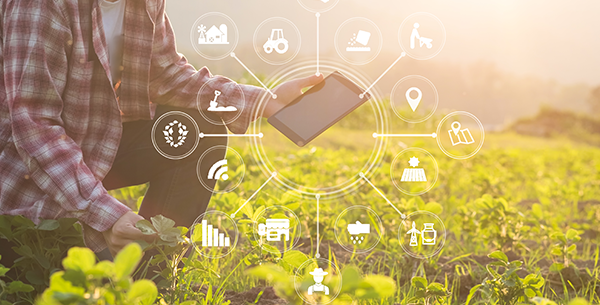
At Qualcomm Ventures, we invest in companies that find innovative uses for technology to reshape industries. We have a thesis centered approach to investing and we focus on the impact of technologies such as 5G, AI, and IoT. Our portfolio reflects that and the companies we have invested in utilize technology to revolutionize different sectors of the economy.
We are constantly looking for opportunities to be at the forefront of transforming industries. Which is why we’ve spent the better part of 2021 studying agriculture. After conducting extensive research, including speaking to several farmers, agronomists, startups, VCs, and incumbents, we believe that a huge opportunity exists in AgTech.
Why AgTech?
Agriculture is a massive industry with a market value in the trillions of dollars. It is also of extreme importance as it supplies food for the entire world population. Yet, it’s behind other industries in terms of digitization.
Over the past few years there’s been an increase in the number of investments being made in AgTech as well as significant growth in invested dollars. We have also seen Series A and B rounds becoming a bigger percentage of the deal share as the industry becomes more mature and companies pick up more traction.
Why Now?
We wanted to understand what was behind this momentum. Aside from existential circumstances such as climate change and the need to feed a growing population, we focused on two tailwinds that we see as drivers for the current state of the industry.
One tailwind is around digitalization. As mentioned, agriculture has digitalized more slowly than other industries due to the lack of connectivity in rural and remote areas. However, connectivity is improving in those areas as more cost-effective infrastructure solutions become available. With improving connectivity more digital solutions can be developed and operated inside the farm. Big Ag companies are acting on this phenomenon as evidenced by Syngenta’s purchase of Strider (QCV portfolio company) and the creation of Syngenta Digital, and as seen with John Deere, which currently employs more software engineers than mechanical engineers. Big Ag sees digital farming as the future but struggles to innovate due to the high demands of keeping up with their core businesses — which leaves a big opportunity for AgTech startups to fill the gap.
The second tailwind we identified is increased demand for sustainable practices and traceability in the food chain. This is driving the need for farmers and other members of the value-chain to adopt technology. Apart from external demand, growers also want technology for better financial results and/or a better quality of life. We believe these demands will keep growing.
Challenges & Opportunities
While these tailwinds are promising we understand that there are some challenges that make it hard to be an entrepreneur in AgTech. Before going into these challenges, some clarifications are in order.
So far we have been talking about agriculture as if it was one thing, which it’s not. Agriculture is the process of growing food, to oversimply. It is a broad category. A one-size fits all solution to the problems faced by agriculture does not exist because there are different problems faced by producers of tomatoes, lettuce, poultry, dairy, and hundreds of other items. These problems can also vary drastically based on geography, farm size, and countless other variables. It’s a very complex industry.
We have so far been focusing on farmers as the main actor in the agriculture industry. While we will continue to do that throughout this piece given that their challenges and opportunities are less understood, there are many players in the agriculture value-chain such as input companies, machine manufacturers, food processors, and the list goes on.
Finally, technology in agriculture can mean many things, from biotech to robotics. Given our investment thesis, we are focusing on the use of technologies such as 5G, AI, and IoT in AgTech.
Back to the challenges—there’s the issue of connectivity. The lack of connectivity infrastructure constraints use-cases and with fewer use-cases there is less incentive to build connectivity infrastructure, generating a negative cycle. However, that is changing. Connectivity solutions are becoming more cost effective and use-cases more prevalent, slowly reverting the cycle in many areas. As part of that, Qualcomm is bringing 5G across the entire population including rural areas, which would drastically accelerate the adoption of digital agriculture.
Technology adoption in agriculture, despite its tailwinds, also faces challenges. Before adopting a new technology, farmers will test it to see if it will give them the expected results. However, testing takes time and there can be several non-controllable variables that can make it difficult to measure the impact of a solution. Nevertheless, when there is a positive ROI it can be very widely adopted as evidenced by the quick shift to Monsanto’s Roundup Ready soybean seed by Brazilian farmers in the early-2000s.

Structure of Agriculture
Agriculture has a complex value-chain and there are many ways to slice-and-dice it. We think about the industry by separating the activities that happen before, inside, and after the farm. We see AgTech companies offering technological solutions to problems across the entire value-chain.
Before the farm there is input purchasing, R&D (e.g. genomics), credit and insurance, etc. There is a lot that goes on before a seed is put in the soil.
Inside the farm is what most think of when they think of agriculture. Here is where crop and livestock management, disease control, irrigation, and so many other activities take place. Farmers, agronomists, and their labor forces are active in this segment. There are many ways to think about companies in this leg of the value-chain and here is where you see startups developing technology solutions such as soil sensors, weather stations, drones, robots, farm management software, and thousands of others. A lot of the challenges we talked about in the previous section are concentrated on activities happening inside the farm given their usual geographical locations. There appears to be a lot of opportunity for AgTechs to revolutionize life inside the farm.
After the farm there is food processing, logistics and distribution, and everything in the food supply chain dealing with post-harvesting, until it reaches the end consumer. This segment is very broad with new categories frequently being invented, such as innovative foods. The logistics, distribution, and traceability activity for AgTech is booming and given our experience in logistics we are very interested in opportunities in this segment of the value-chain.
Fulfilling Farmer’s Demand
Apart from its impact on profitability and/or quality of life, the way farmers interact with the technology is also important and an indication of how successful the startup will be. People are not keen on managing multiple systems that provide them incremental value. Instead, technology solutions that can easily integrate with farmers’ existing systems and work processes, have the most potential. End-to-end solutions that can capture data, process it intelligently, and provide actionable insights (e.g. irrigate tomorrow instead of today) likely add the most value. The companies that are leading the market and getting traction understand that well, and the traction reflects the existing demand for such solutions.
Farmers want technology, better yields, lower cost, more informed decision-making, and many other improvements, but it is hard to do. AgTechs have their work cut-out for them. Entrepreneurs that can clearly provide value with cutting-edge technology and a smart go-to-market strategy and pricing model can build an incredible business.
Qualcomm Ventures’ Role
Qualcomm can play a role in enabling the digitalization of farms. Since its inception, Qualcomm has invented breakthrough technologies that transform how the world connects, computes, and communicates. That technology has helped create entirely new industries, business models and experiences, which extends into the technologies that will transform agriculture.
Qualcomm’s expertise in communications technology (with over 140k patents) and in hardware development can be of tremendous value to AgTech companies that are developing solutions for this space. Nearly every industry will be digitally transformed, and Qualcomm invents the foundational technologies that will empower the next generation of innovation.
At Qualcomm Ventures, our investments help bold entrepreneurs build revolutionary businesses, including in the AgTech space, with successful investments in Prospera and Strider , and an exciting portfolio company in Stellapps. We have over twenty years of experience in Venture Capital and an unmatched global network to help founders scale their companies. We are excited about the opportunities in AgTech and are looking to expand our portfolio companies in this space. If you have any connection to the industry, as a founder or otherwise, please come talk to us!
You can reach out to us here. Access to a summary deck of our thesis can be found here.


